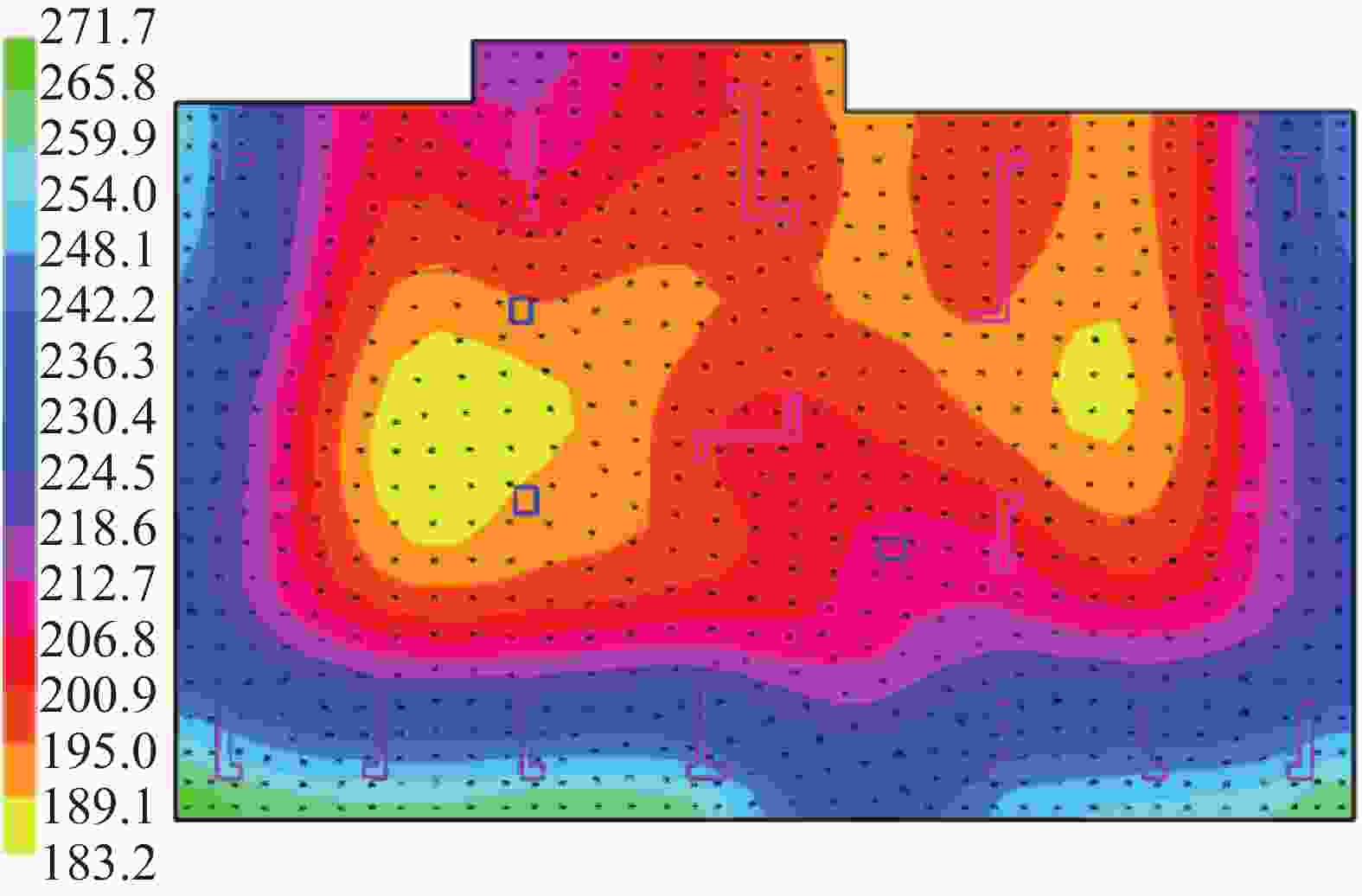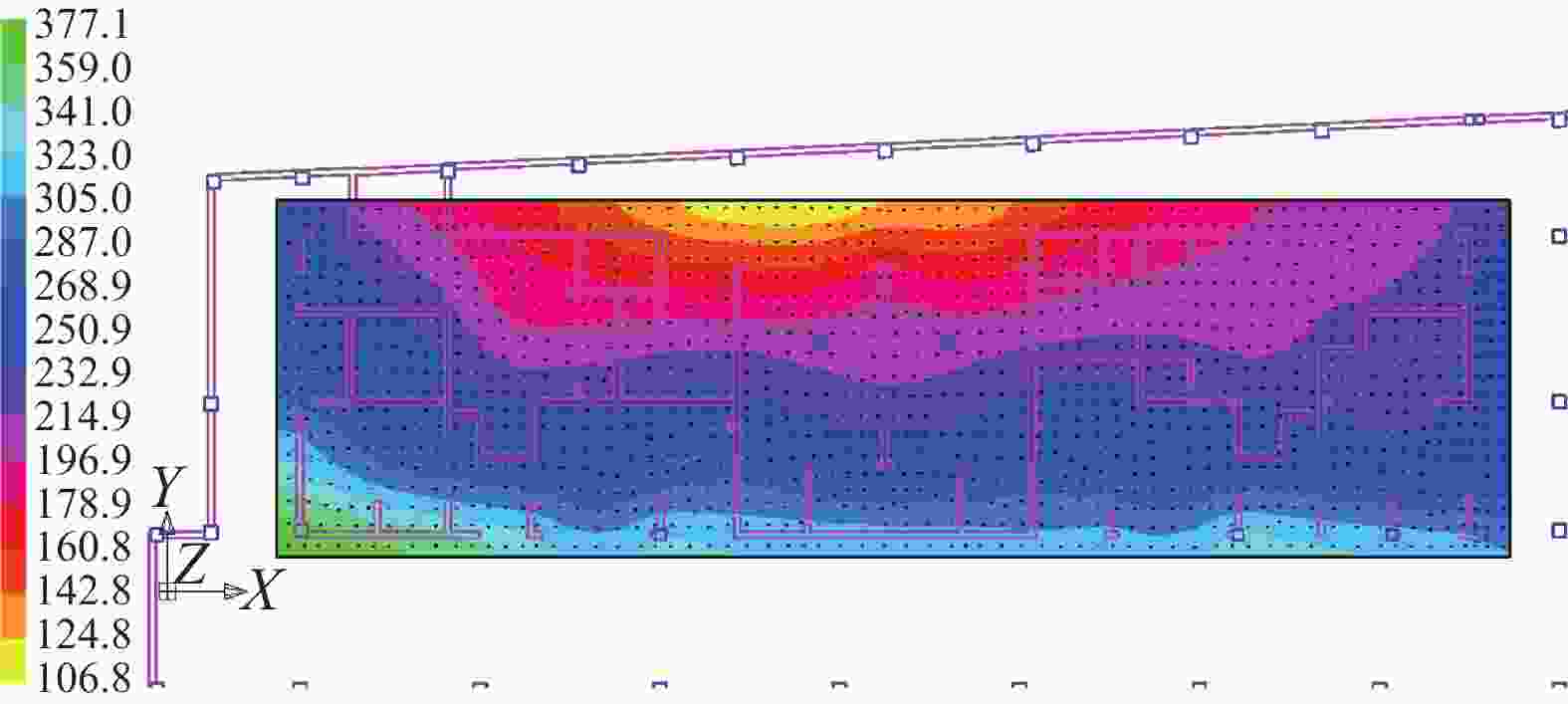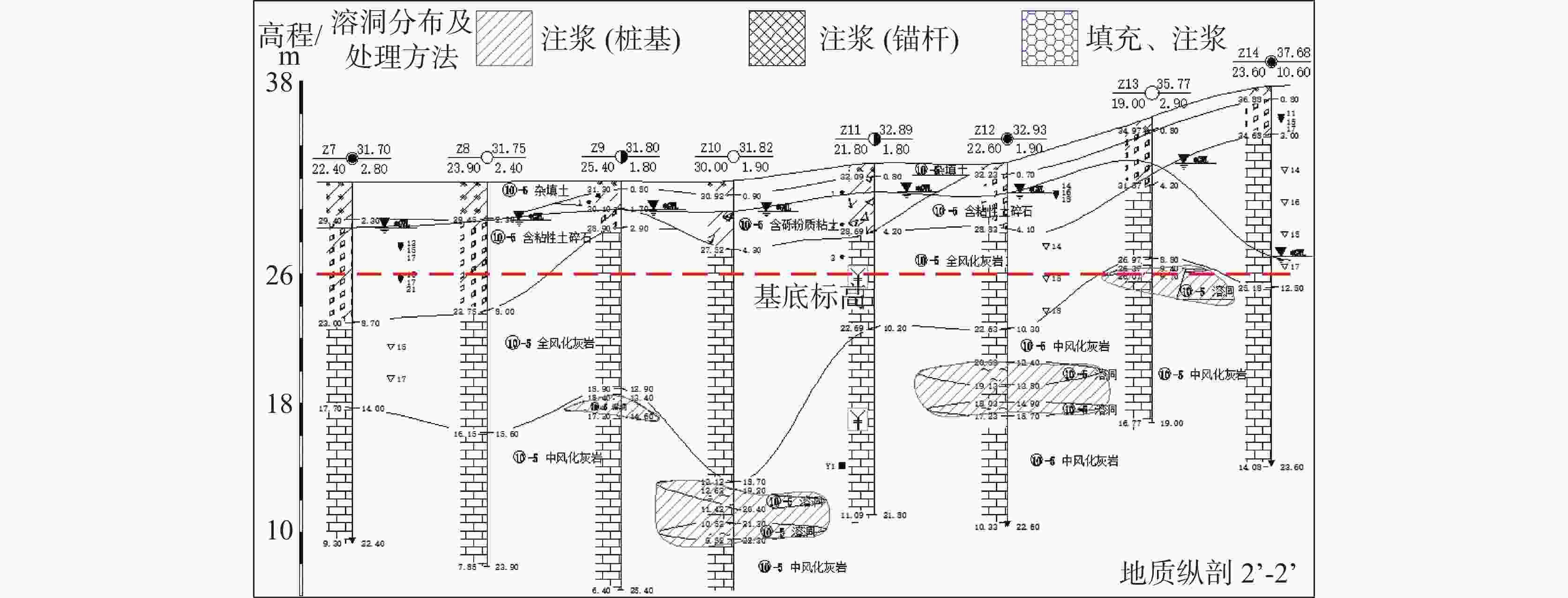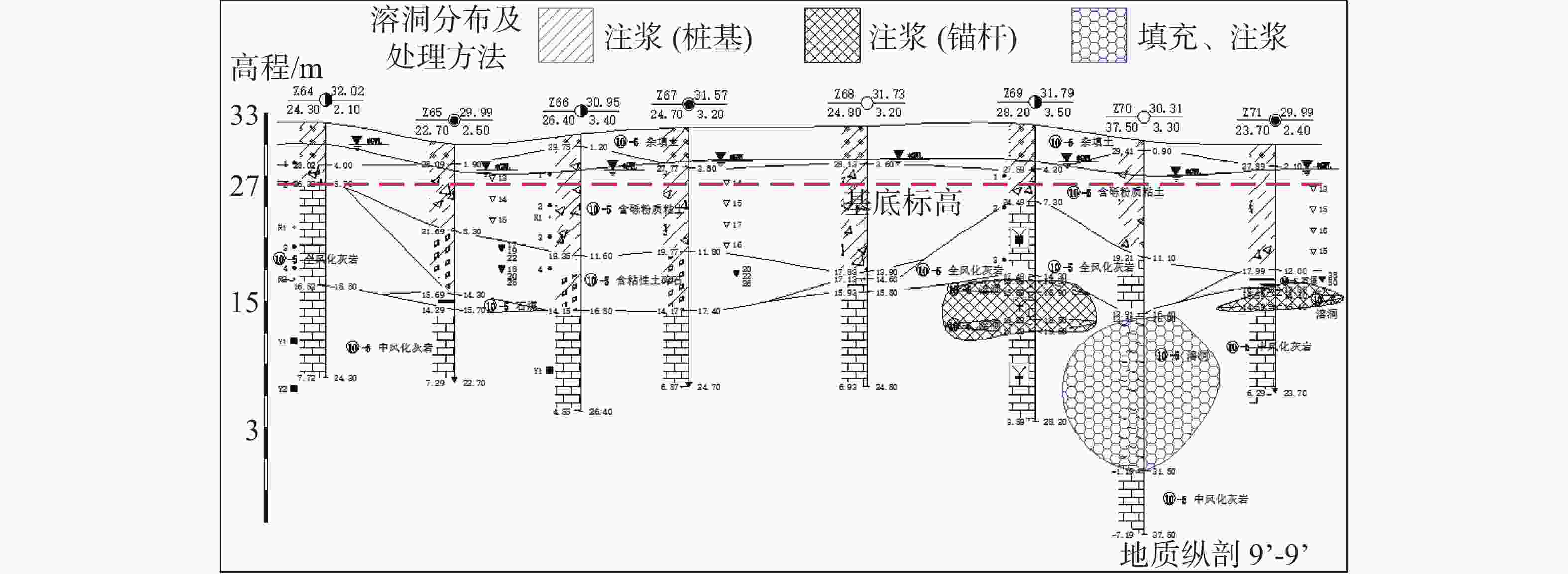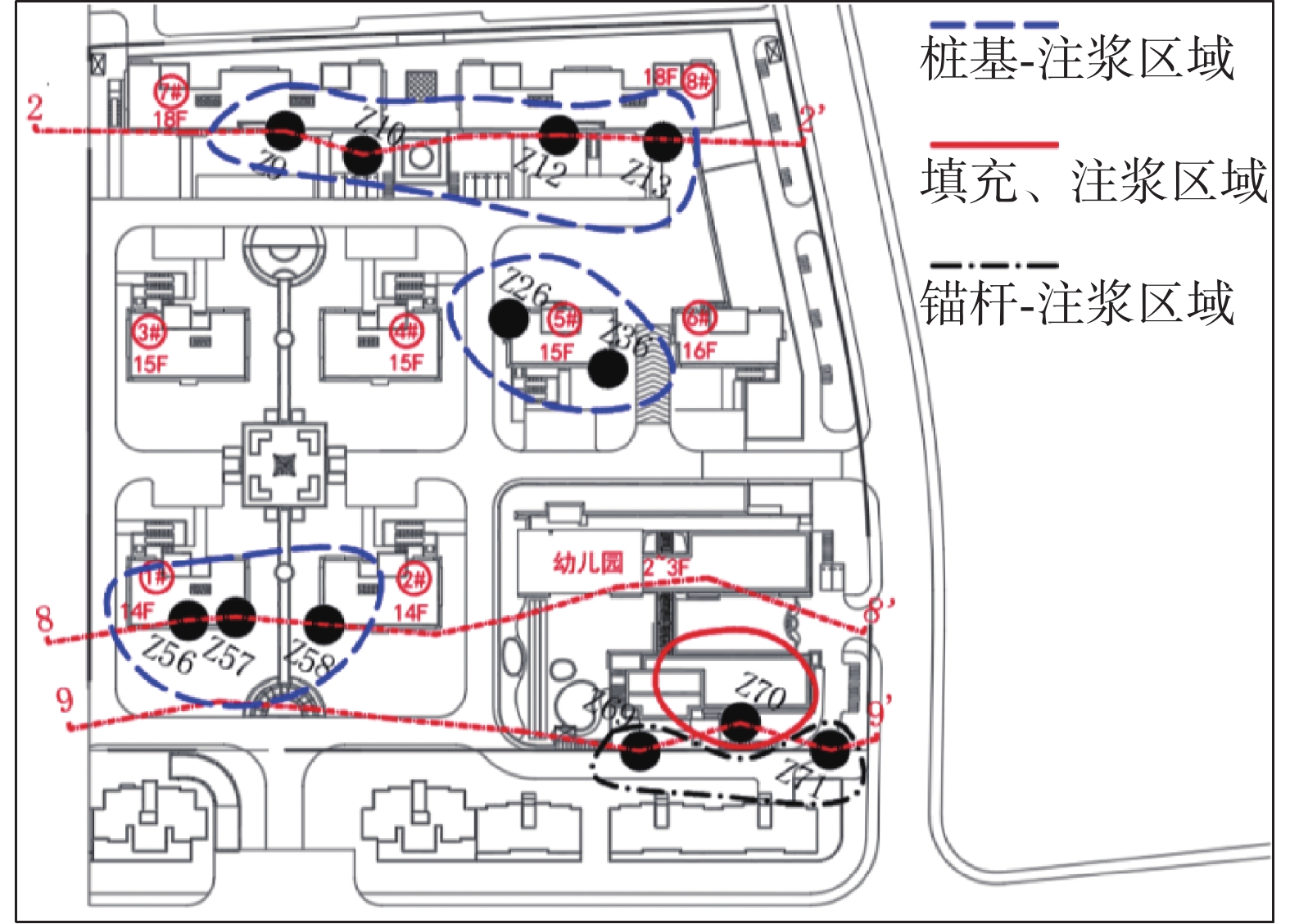Design of foundation and karst treatment for a residential project in a karst development area
-
摘要: 岩溶区特殊的地质结构可能导致一系列严重的工程问题,如地基沉降不均、地基塌陷、地下室渗漏水等,极端情况下甚至会引发地基稳定性丧失和结构损坏。为有效应对这一挑战,研究聚焦于浙江省某岩溶发育区域内的住宅工程项目,对基础设计和岩溶处理技术进行深入探讨。该项目包含8栋14至18层的高层住宅楼、2至3层的幼儿园及单层配套用房,并设置了整体一层的地下室。主体楼座部分采用桩基础设计,单层地下室区域采用筏板基础。鉴于非楼座区域地下室存在的抗浮问题,设计采用了抗浮锚杆,整个工程的地基基础设计等为甲级。勘察报告揭露基岩为可溶性岩石,见洞率为16.6%,以点状溶洞形态居多。针对各种类型的溶洞类型,最终制定全面的基础设计和岩溶处理实施方案。研究成果可为同类岩溶地区住宅建设提供借鉴、参考。Abstract:
With the rapid advancement of construction in China, the development of various buildings and structures in karst regions has been increasing. However, the challenges posed by karst geology cannot be overlooked, as it can lead to a series of serious engineering issues such as uneven foundation settlement, foundation collapse, and water leakage in basements. In extreme cases, karst may even result in the loss of foundation stability and structural damage. To effectively address these challenges, this study focused on a residential project in a karst development area within Zhejiang Province and conducted an in-depth discussion on the foundation design and karst treatment techniques of this project. The project comprises 8 high-rise residential buildings with 14 to 18 floors, a 2–3 story kindergarten, and single-story ancillary buildings, along with a one-level basement. Pile foundations were adopted for the main building sections, while a raft foundation was used for the single-level basement area. Considering the buoyancy issues in non-building areas of the basement, anti-floating anchors were employed, and the overall foundation design was rated as Class A. The geological investigation report revealed that the bedrock is soluble, with a cave occurrence rate of 16.6%, mostly in the form of point-like caves. Based on the relevant information above, this study elaborately discussed the foundation design schemes for different parts of the buildings and the basement. Based on the analysis of the base reaction forces under the buildings and the combination of engineering experience with geological conditions, bored piles with diameters of 800 mm and 1,000 mm were selected for the foundations beneath the buildings. After the solution of anti-floating pile was compared with the solution of rock anchor, anti-floating anchors for the conventional basement were planned to be used. For the construction of kindergarten, which required both load-bearing capacity and the ability to span caves, piles with the diameter of 600 mm were chosen as the anti-floating measure. Targeted research on treatment technologies for various types of caves was also conducted. Different karst treatment plans were formulated according to the height of the cave, whether it is ≤4 m for pile foundations or anchor traversals, or >4 m. This study provided construction considerations for cave treatment, including the adverse effects of caves on pile construction, the determination of the bearing stratum for engineering piles, and key matters such as pile testing. To ensure reliable karst treatment, quality inspections were equally important. These inspections confirmed that the cave treatment, integrity, and bearing capacity of the pile positions treated according to the principles outlined in this paper meet the code requirements, which can also validate the rationality of the results presented herein. Ultimately, this study has developed a comprehensive foundation design and karst treatment implementation plan for the project. Currently, there is a lack of discussion on the design of large-scale basements with flat rafts plus anti-floating anchors, and residential buildings with flat rafts plus bored piles in karst-developed areas. This study can provide certain reference for the design of related projects. -
Key words:
- karst /
- karst treatment /
- foundation design /
- anti-floating anchor rod /
- pile foundation
-
表 1 地层分布一览表
Table 1. Stratigraphic Distribution Table
土层编号 土层名称 土层厚度/m 土层性质 ① 杂填土 6.70~0.40 结构松散,工程性能及均一性差 ②-1 含砾粉质黏土 10.40~0.90 中等压缩性,切面粗糙,干强度高 ②-2 含黏性土碎石 6.60~0.60 粗颗粒的矿物成分主要为长石、石英等,岩质坚硬 ⑤-1 全风化灰岩 14.40~0.60 可塑为主,局部硬可塑,风化成泥土状,夹砂砾,原岩结构清晰可辨,手掰易碎 ⑤-0 溶洞 14.60~0.50 岩芯不成形、烂泥状,夹少量中风化岩块,岩石表面可见明显溶蚀凹槽 ⑤-夹层 石煤 4.40~1.40 夹大量0.5~2 cm煤屑,手掰易碎 ⑤-3 中风化灰岩 最大揭露厚度16.10 m 岩芯多呈柱状、短柱状,少量碎块状,锤击声脆,较难击碎,
岩石质量指标RQD值为10%~70%表 2 岩溶分布统计表
Table 2. Statistical Table of Karst Distribution
序号 钻孔编号 岩溶发育孔段/m 洞高/m 充填物性状 1 Z9 13.40~14.60 1.2 灰色,含黏性土碎石充填 2 Z10 19.20~20.40 1.2 无充填 21.30~22.30 1.0 3 Z12 12.40~13.80 1.4 灰黄色软塑含砾粉质黏土充填,砾石粒径2~4 cm,干钻进尺较快 14.90~15.70 0.8 灰黄色流塑粉质黏土充填,夹少量砾石 4 Z13 9.40~9.70 0.3 灰黑色软塑含砾粉质黏土充填,砾石粒径2~4 cm 5 Z26 7.80~8.30 0.5 无充填 8.70~9.20 0.5 灰黄色流塑粉质黏土充填,夹少量砾石 6 Z36 5.90~6.90 1.0 灰黑色含黏性土砾砂充填,干钻易进尺 7.50~8.50 1.0 7 Z56 10.80~11.40 0.6 灰黄色软塑粉质黏土充填,夹少量砾石 12.40~12.70 0.3 8 Z57 11.50~12.10 0.6 无充填 12.70~13.20 0.5 9 Z58 12.50~13.10 0.6 灰黄色含黏性土碎石充填 10 Z69 14.80~15.90 1.1 灰黄色流塑状黏性土充填,含少量砾砂 18.50~19.60 1.1 灰色软塑含砂粉质黏土充填 11 Z70 16.90~31.50 14.6 上部基本无充填,掉钻,底部31.4~31.5 m为含黏性土碎石充填 12 Z71 14.40~15.40 1.0 无充填 表 3 基底反力统计表
Table 3. Statistics of foundation reaction
楼号 地上层数 典型勘点 基地土层 承载力/kPa 基底反力/kPa 距离中风化灰岩距离/m 1# 14 Z56 含砾粉质黏土 140 190~270 平均约6.8 2# 14 Z58 含砾粉质黏土 140 190~270 平均约7.4 3# 15 Z31 含黏性土碎石 220 210~300 平均约2.0 4# 15 Z34 杂填土 0~100 210~300 平均约1.8 5# 15 Z35 全风化灰岩 180 210~300 平均约1.5 6# 15 Z37 含黏性土碎石 220 210~300 平均约0.5 7# 18 Z9 全风化灰岩 180 130~380 平均约7.4 8# 18 Z12 全风化灰岩 180 130~380 平均约3.5 幼儿园 3 Z61 全风化灰岩 180 30~90 平均约5.5 表 4 抗浮措施比选表
Table 4. Comparison of anti-floating measures
受力特性
(地下室仅
需抗拔)每延米
造价
元/m岩石层每延
米抗拔力
特征值/kNA.抗拔桩
(600 mm)受拉/受压 500 130 B.岩石锚杆
(3xHRB400 22)仅受拉 130 120 表 5 抗浮措施参数表
Table 5. Parameters of anti-floating measures
持力层 进入持力
层深度/m抗拔承载力
特征值kNA.抗拔桩
(600 mm)中风化灰岩 ≥3 350 B.岩石锚杆
(3xHRB400 22)中风化灰岩 ≥1.5 180 表 6 处理方式统计表
Table 6. Statistics of treatment method
序 号 钻孔编号 处理方法 1 Z9、Z10、Z12、Z13、Z26、
Z36、Z56、Z57、Z58桩基-注浆 2 Z70 先填片石、级配,注浆 3 Z69、Z71 锚杆-注浆 -
[1] 刘之葵. 岩溶区溶洞及土洞对建筑地基影响的研究[D]. 长沙:中南大学, 2004.LIU Zhikui. Study on effect of cave and cave soil on building foundation in karst region[D]. Changsha: Central South University, 2004. [2] 吴春寅, 曹锋, 朱嗣昭, 孙晋阳, 周庆富, 许公瞻, 华涛, 陈波. 山东省枣庄市十里泉、丁王庄一带地面塌陷的成因及防治对策[J]. 水文地质工程地质, 1998(5): 27-29. [3] 康彦仁. 岩溶地面塌陷的形成条件[J]. 中国岩溶, 1988, 7(1):9-17.KANG Yanren. Forming condition of land collapse in karst regons[J]. Carsologica Sinica, 1988, 7(1): 9-17. [4] 李治国. 隧道岩溶处理技术[J]. 铁道工程学报, 2002, 19(4):61-67. doi: 10.3969/j.issn.1006-2106.2002.04.014LI Zhiguo. Technology of treatment for karst encountered in tunnel construction[J]. Journal of Railway Engineering Society, 2002, 19(4): 61-67. doi: 10.3969/j.issn.1006-2106.2002.04.014 [5] 龙艳魁. 长沙地铁1号线工程岩溶洞穴稳定性及其病害处理研究[D]. 长沙:中南大学, 2012.LONG Yankui. The study of stability and processing technology of karst caves in Changsha Metro Line 1[D]. Changsha: Central South University, 2012. [6] 李广涛. 广州地铁三号线北延段岩溶处理设计[J]. 隧道建设, 2009, 29(1):61-64.LI Guangtao. Design of karst treatment: Case study on north extension section of No. 3 line of Guangzhou metro[J]. Tunnel Construction, 2009, 29(1): 61-64. [7] 李陆平, 尤继勤, 王吉连. 蔡家湾汉江特大桥钻孔桩施工及岩溶处理技术[J]. 桥梁建设, 2009(5):60-63.LI Luping‚ YOU Jiqin, WANG Jilian. Techniques of construction and karst ground handling for bored piles of Caijiawan Hanjiang river bridge[J]. Bridge Construction, 2009(5): 60-63. [8] 刘瑞琪. 城市岩溶区地铁隧道的溶洞超前探测及处治技术[J]. 石家庄铁道大学学报(自然科学版), 2012, 25(2):42-46.LIU Ruiqi. Construction treatment technology for city metro in karst area[J]. Journal of Shijiazhuang Tiedao University (Natural Science), 2012, 25(2): 42-46. [9] 蒋忠信, 秦小林, 袁茂林, 唐晓春. 南昆铁路典型隧道区溶洞研究[J]. 铁道工程学报, 1995,12(1):53-62.JIANG Zhongxin, QIN Xiaolin, YUAN Maolin, TANG Xiaochun. Research of typical solution cave in tunnel region on Nanning-Kunming railway[J]. Journal of Railway Engineering Society, 199, 12(1): 53-62. [10] 王青. 桥梁桩基岩溶处理方法分析[J]. 现代交通技术, 2013, 10(1):24-26.WANG Qing. Analysis of treatment for bridge pile foundation in karst area[J]. Modern Transportation Technology, 2013, 10(1): 24-26. [11] 蒋继昭. 南(宁)柳(州)高速公路洛维大桥桩基岩溶问题[J]. 广西交通科技, 1998, 23(3):22-23. [12] 匡乐红, 彭振斌. 在工业与民用建筑中岩溶地基处理方法探讨[J]. 岩土工程界, 2001, 4(11):43-44. [13] 姜燕, 杨光华, 黄忠铭, 乔有梁, 张玉成. 复杂岩溶场地下的高层建筑地基处理[J]. 岩土力学, 2015, 36(Suppl.1):430-438.JIANG Yan, YANG Guanghua, HUANG Zhongming, QIAO Youliang, ZHANG Yucheng. Ground treatment of high-rise buildings in complex karst region[J]. Rock and Soil Mechanics, 2015, 36(Suppl.1): 430-438. [14] 建筑地基基础设计规范:GB50007-2011[S]. 北京:中国建筑工业出版社出版, 2011.Code for design of building foundation: GB50007-2011[S]. Beijing: China Architecture and Building Press, 2011. [15] 张俊萌, 方从启, 朱杰, 朱俊峰. 超深层岩溶地基上高层建筑桩筏基础性能研究[J]. 地下空间与工程学报, 2015, 11(2):343-349.ZHANG Junmeng, FANG Congqi, ZHU Jie, ZHU Junfeng. Research on performance of pile-raft foundation of high-rise building on ultra deep karst ground[J]. Chinese Journal of Underground Space and Engineering, 2015, 11(2): 343-349. [16] 李想, 尹骥, 卫佳琦, 韦马季. 深覆盖岩溶地区高层建筑桩基优化实践[J]. 中国岩溶, 2019, 38(4):591-599. doi: 10.11932/karst20190418LI Xiang, YIN Ji, WEI Jiaqi, WEI Maji. Optimization of pile foundation for high-rise buildings in deep-covered karst areas[J]. Carsologica Sinica, 2019, 38(4): 591-599. doi: 10.11932/karst20190418 -




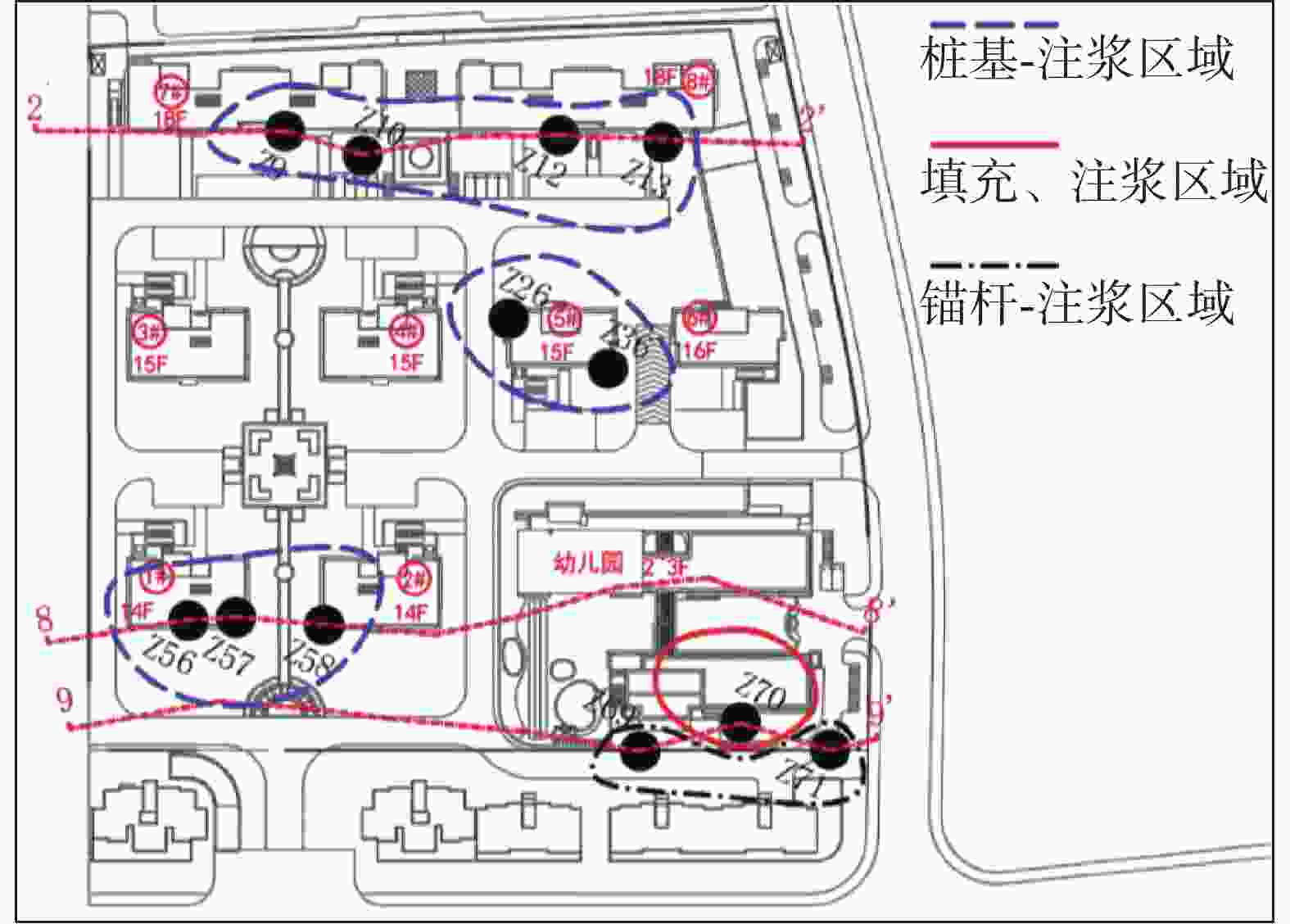
 下载:
下载:
